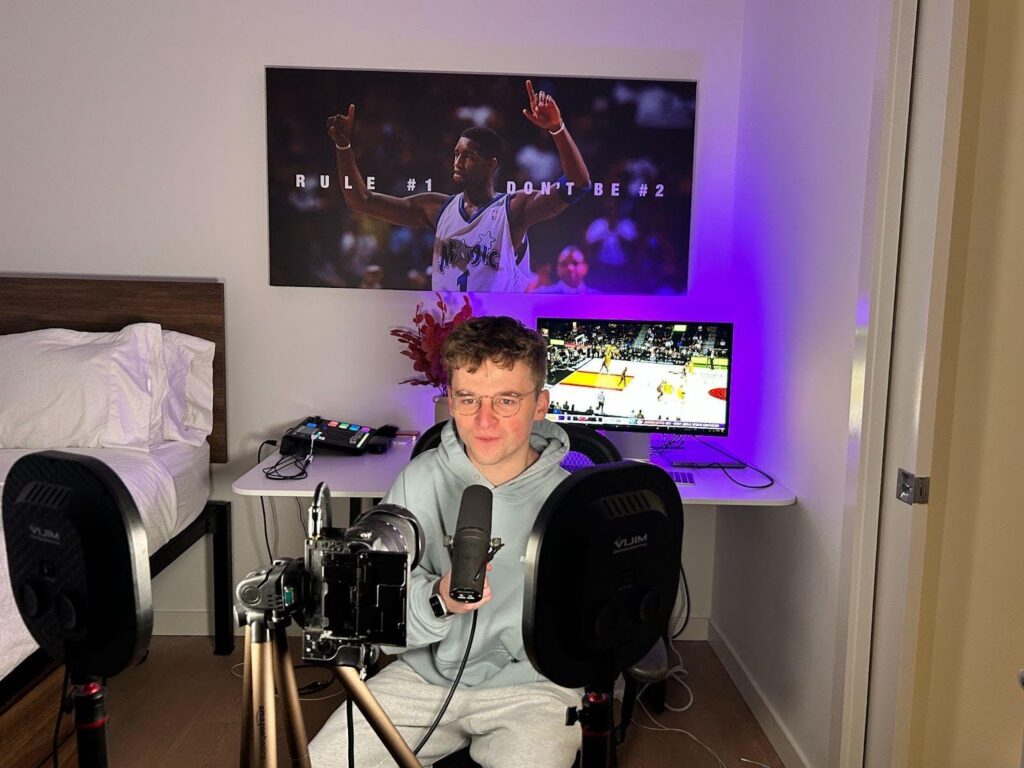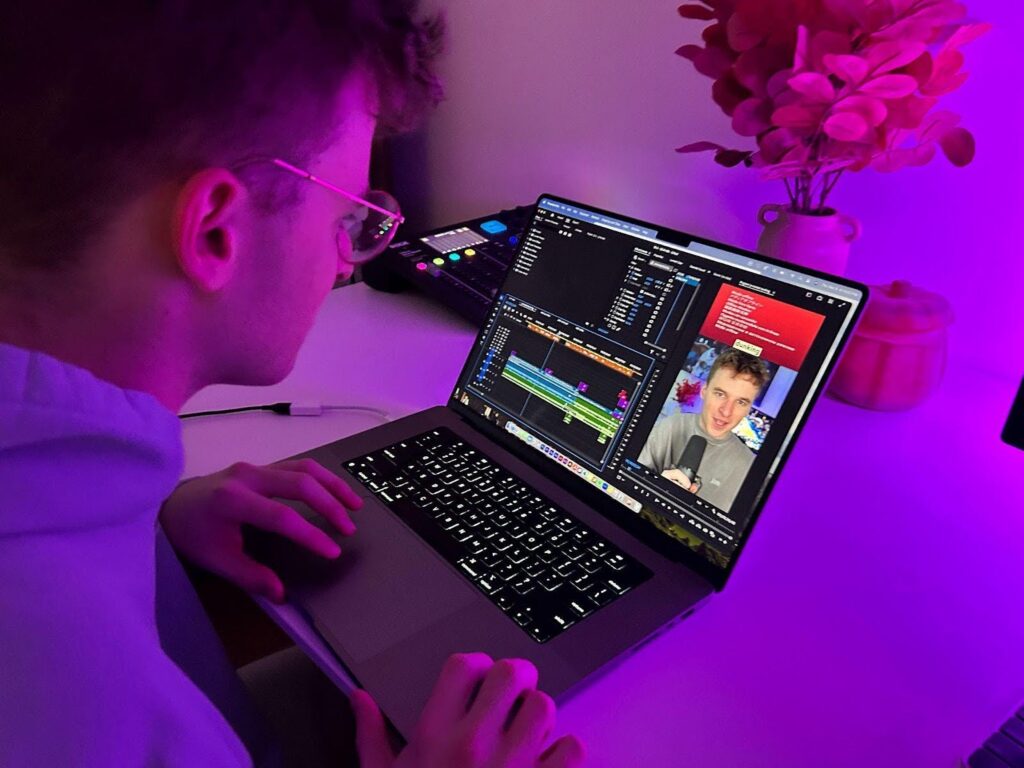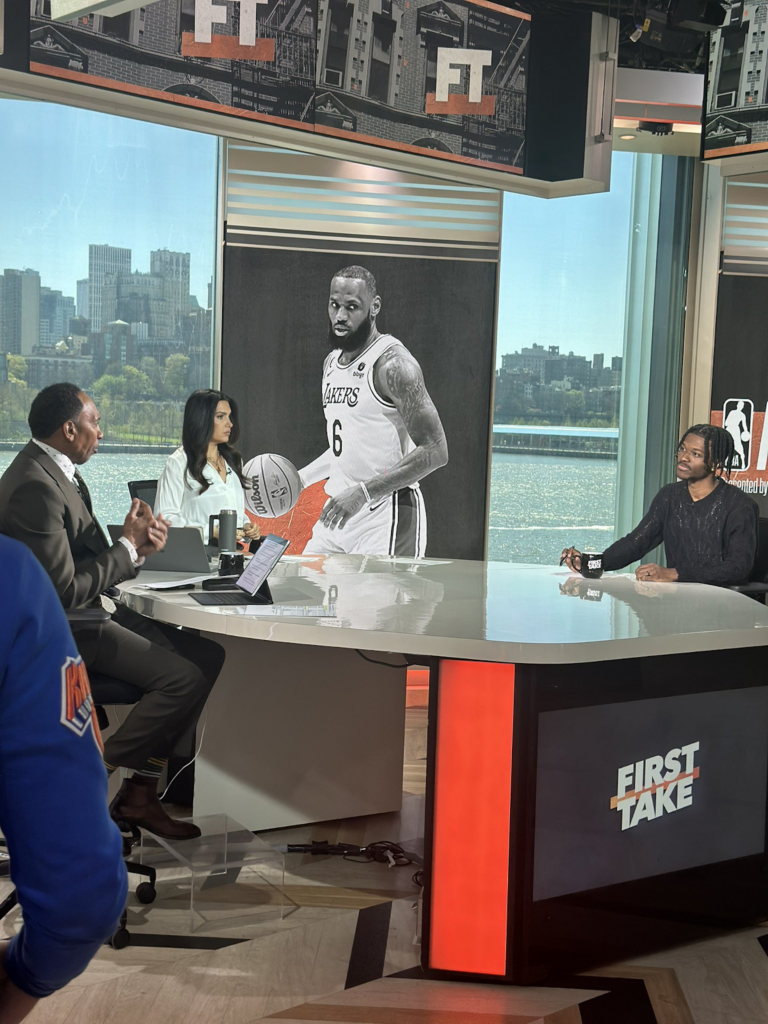ESPN vs. Content Creators: The battle for the future of sports media
ESPN, content creators battle for sports media’s future
As ESPN’s audience declines, a new wave of young creators bring analysis and personality to basketball commentary.

Ben Casalinho’s eyes dart around his MacBook Pro, rarely staying on a single screen for more than a moment. He’s hunting for crucial data to strengthen his argument: Naz Reid, reigning NBA Sixth Man of the Year, might be the Minnesota Timberwolves’ most undervalued asset. “I know I can find his per 36 [minutes] on Basketball Reference. I’ve done this shit a million times,” Casalinho stammers.
Casalinho is preparing the script for his next YouTube short, a 35-second video detailing how Reid’s efficiency on the court is similar to that of star Karl-Anthony Towns, the homegrown Timberwolf who was traded away. The stakes seem personal for Casalinho, almost as if it’s his life’s mission to prove a bench player’s value. Maybe that’s because this is his life’s mission. Casalinho is creating short-form content for his 182,000 YouTube subscribers, a niche NBA-centric fanbase that opts for analysis over the superficial segments seen on outlets like ESPN.
The 21-year-old Syracuse University senior is just one of an emerging crop of digital commentators shifting the way fans interact with basketball analysis. An area once dominated by seasoned network journalists now centers around the material itself. Content is king, and every basketball creator with a laptop and microphone is gunning for the throne.
ESPN, the self-proclaimed “worldwide leader in sports,” has faced a noticeable financial and influential decline in recent years. In the early 2010s, the network collected $7 per month from each of its 100 million subscribers. But by 2023, the company had lost approximately 30 million of those subscribers. As Ben Shields, former director of Social Media and Marketing at ESPN, points out, “The economics of ESPN’s streaming don’t quite make up for the revenue lost from the cable satellite side, and then, they have to make choices.”
One of those choices was made when ESPN senior basketball writer Zach Lowe, a staple of the network’s NBA coverage, was fired in September 2024. (Lowe declined to comment for this story.) His removal isn’t the first cost-cutting layoff to jeopardize ESPN’s household status. Famous sports commentary names like Bill Simmons, Max Kellerman, Jemele Hill and Jeff Van Gundy were all removed from the network within the past decade. Still, Lowe’s departure marks a turning point in an ongoing trend: traditional sports media is no longer the only game in town.

Short-form, big impact
Platforms like Instagram, TikTok and YouTube have birthed a new generation of analysts, or maybe just people on their couches with microphones. These creators, often in their early to mid-twenties, blend entertainment with insight, offering scrollers easy-to-digest content. Among them is Casalinho, who has mastered that balance between substance and showmanship. His videos aren’t just about presenting stats; they’re also about finding ways to grab his viewers’ attention.
“If it’s visually appealing, people will watch it,” he says. “You want to give substantive reasoning, not just saying, ‘Oh, I think they won the trade.’”
Casalinho’s approach to sports commentary is clear: analysis over hot takes. “I don’t give a shit about ranking players,” he says. “Why does anyone care about my top 10 power forwards? I focus on analysis, not memes.”

Casalinho’s videos depart from the factory-produced commentary that’s defined much of NBA content. Unlike commentators’ intentionally polarizing segments on ESPN’s flagship debate show, First Take, Casalinho’s videos cultivate a brand built around data-driven analysis that prioritizes context over what he views as brash, often ridiculous opinions.
Casalinho and his peers — like Andrew Fenichel, a sports content creator with over 100,000 YouTube subscribers — are growing fanbases by speaking directly to them, bypassing traditional broadcast networks.
“I sort of consider myself right in the middle of entertaining and informative,” Fenichel says. “I don’t really consider myself a journalist. I focus on being a personality first.”
The importance of personality in sports media has already made its way into the classroom, says Professor Olivia Stomski, Director of the Newhouse Sports Media Center at Syracuse University. “Personality makes you different,” Stomski says. “We teach that here. People want you. They want your personality, or they don’t.”
For fans of the NBA and the drama that surrounds it, the DIY sports content creator doesn’t only offer personality, but also a sense of authenticity that ESPN pundits seem to lack.
“They don’t have to be like journalists; they kind of just say what they want,” says Jack Taliano, one of Casalinho’s fans.
Short-form content offers instant gratification in a world where attention spans are shrinking. All Casalinho or Fenichel need is 30 seconds to discuss an emerging player’s performance and shape opinions.
While audience trust is crucial for these TikTok stars, their primary focus is on captivating and maintaining the attention of their followers.
“You have to understand, like, Pat McAfee, Stephen A. Smith, it’s about entertainment, bro,” Casalinho says of the current sports media landscape.
A study by Morning Consult revealed that Gen Z watches nearly 20% less live sports than adults, preferring sub-minute-long videos instead. “Sports is just a byproduct of a giant societal migration from a set of old 20th-century platforms to a new set of 21st-century platforms,” says Kirk Goldsberry, former lead analyst for Team USA Basketball and podcaster at The Ringer.
ESPN in crisis
As audiences demand more snackable content, ESPN faces the challenge of adjusting to this short-form world. Despite efforts to go digital with an online subscription service, ESPN+, the network’s standard subscriber base has gradually disappeared. Tens of millions of subscriber cancellations hurt ESPN’s bottom line, while costs for streaming rights for live sports like the NBA continue to soar.
“We’ve caused the layoffs at ESPN,” says 22-year-old NBA fanatic Tommy Cleland, who’s completely shifted to short-form content for his sports consumption.
While live sports draw significantly more viewers to ESPN than First Take, viewership of live NBA games on ESPN is down 28%. For Shields, content reinvention is ESPN’s best opportunity to flourish. “They should continue to innovate how live games are presented, especially as they launch ESPN Flagship, its direct-to-consumer app. It could be an opportunity to rethink how fans watch and engage in live events,” he says.
The network hasn’t remained stagnant, though: it’s introduced ESPN BET, a sports gambling service that arrived years after industry giants DraftKings and FanDuel had already established themselves. Omar Raja, founder of the viral Instagram account House of Highlights, left to join ESPN in 2020, but the now Raja-run SportsCenter Instagram page trails House of Highlights by more than 13 million followers.
ESPN even tried to make SportsCenter more casual, as the television program shifted its content to Snapchat. J.A. Adande, Hall of Fame ESPN sportswriter and Director of Sports Journalism at Northwestern University, notes that the results were less than ideal: “My students grew up with the traditional SportsCenter, and seeing someone standing up in a hoodie didn’t feel right to them. Maybe it will be embraced one day, but it’s hard to know.”
While ESPN has struggled over the past decade, it remains the dominant name in sports media. As a subsidiary of the Walt Disney Company, the network benefits from a solid financial safety net. “ESPN isn’t going anywhere anytime soon,” Adande says. “People will still turn to ESPN for live events. But the future of daytime programming? That’s still uncertain.”
Authenticity or accuracy
This new era of Instagrammable basketball commentary has sparked concerns about the future of sports journalism. While flashy visuals and personality are critical for influencer content, questions of credibility remain a significant concern. “Journalists are supposed to speak truth to power,” says Simon McEnnis, author of Disrupting Sports Journalism. “If they lose sight of that, they’re just like any other influencer, and credibility could be lost. Journalists have got to be calling out injustice.”
However, McEnnis also believes that traditional sports media and influencers need each other. “Influencers rely on sports journalists to provide the content they react to. Without traditional journalism, a lot of influencers would be lost. It’s completely interdependent,” he explains.
While McEnnis sees an overlap between traditional sports journalism and influencers, others, like Adande, draw a clear distinction.
“Journalism is about telling true stories that would not otherwise be told,” Adande argues. “Content creators are just that—creating content. There’s journalism, there’s reporting, and then there’s content creation. It’s important to recognize those as different things.”
Without set guidelines, creators may prioritize engagement over accuracy, which poses a real risk for audiences. While these influencers certainly have the right to express opinions, those opinions come with the responsibility to provide factual content.
What’s next for sports journalism?
ESPN may have to look to more short-form creators like Casalinho and Fenichel for a wider reach. Just this year, the network began integrating new short-form content creators into its programming, marking a sign of things to come. A personality like Kenny Beecham, who started making NBA-related content on YouTube in high school, found himself on the First Take desk just eight months ago, debating (arguably) the face of sports television commentary, Stephen A. Smith. Beecham’s First Take debut marked the first meeting between traditional sports journalism and creator-driven commentary.

Sports content won’t be passively consumed anymore: it’s already become an experience where fans can interact directly with creators who are algorithmically tailored to their interests. Audiences today don’t want to watch the “old guard.” They want to see people who look, sound, and think like them. It’s a reminder that authenticity, not aesthetics, is what ultimately resonates.
“I like that it’s a one-on-one conversation, not professional and set up. It’s just raw opinions,” Taliano says.
With live broadcasts still drawing millions, ESPN holds an important piece of the future, but it can’t afford to ignore the seismic cultural shift happening underneath its feet.
The battle for the future of sports commentary is no longer about who can yell the loudest on debate shows: it’s about who can authentically connect with fans and give them the content they seek on the formats they crave. It’s now just a matter of when, not if, the balance of power tips the other way.
